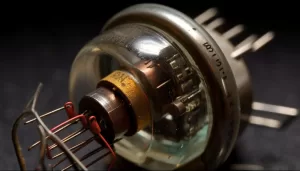
How to Test A Blower Motor Resistor?
September 12 2023  1204
1204
Inquiry
Global electronic component supplier AMPHEO PTY LTD: Rich inventory for one-stop shopping. Inquire easily, and receive fast, customized solutions and quotes.
QUICK RFQ
ADD TO RFQ LIST
This blog explores the definition and location of a blower motor resistor, as well as provides guidance on how to perform testing and replacement procedures.
What is A Blower Motor Resistor?
A blower motor resistor is an electrical component within a vehicle's HVAC system that utilizes the relationship between resistors and current flow to regulate the speed of the blower motor. In the case of a blower motor resistor, it is designed with multiple resistors of varying values. These resistors create different levels of electrical resistance, which determine the speed at which the blower motor operates. By adjusting the resistance in the circuit, the blower motor resistor controls the amount of current flowing to the blower motor. This, in turn, affects the rotational speed of the blower motor and controls the airflow within the vehicle's HVAC system.
Blower Motor Resistor Location
Blower motor resistor location varies by vehicle make, model, and year. Common areas for finding it exist: Under the Dashboard: The blower motor resistor is often located underneath the dashboard on the passenger side of the vehicle. It is commonly positioned near the blower motor itself or within the HVAC unit. Engine Compartment: In some vehicles, the blower motor resistor can be found in the engine compartment. It may be mounted on the firewall, near the blower motor housing, or on the HVAC unit itself. Behind the Glove Box: In certain vehicle models, the blower motor resistor is located behind the glove box. You may need to remove the glove box or access panel to reach it.What Does A Blower Motor Resistor Do?
A blower motor resistor is an electrical component found in a vehicle's HVAC (Heating, Ventilation, and Air Conditioning) system. Its primary function is to regulate the speed of the blower motor, which controls the airflow within the vehicle's cabin. The blower motor resistor achieves speed regulation by introducing different levels of electrical resistance into the circuit that powers the blower motor. It is typically designed with multiple resistors, each corresponding to a specific fan speed setting. When you adjust the fan speed on your HVAC controls, the blower motor resistor receives the signal and adjusts the resistance in the circuit accordingly. By increasing or decreasing the resistance, it controls the amount of current flowing to the blower motor. As a result, the blower motor spins at different speeds, providing the desired airflow inside the vehicle. For instance, when you choose a high fan speed setting, the blower motor resistor reduces the resistance in the circuit, allowing more current to flow to the blower motor. This increases the motor's speed, resulting in higher airflow. Conversely, when you select a low fan speed, the blower motor resistor increases the resistance, limiting the current and reducing the motor's speed for lower airflow. By regulating the blower motor's speed, the blower motor resistor enables you to adjust the temperature, airflow, and overall comfort level inside the vehicle. It ensures that the HVAC system operates efficiently and provides the desired cooling or heating effect according to your preferences.
Symptoms of A Bad Blower Motor Resistor
When a vehicle's blower motor resistor fails, it can cause symptoms indicating a potential issue. The resistor controls the fan speed in the HVAC system. It's quite simple to detect a malfunctioning blower motor resistor, thankfully. If your vehicle's blower motor resistor is not functioning properly, you may notice some common symptoms: Inoperative or Intermittent Fan Speeds: One of the most noticeable symptoms is when the HVAC system's fan operates only at certain speeds or stops working altogether. If you find that the fan only works on the highest setting but not at lower speeds, it could indicate a faulty blower motor resistor. No Airflow from Vents: Another symptom is a lack of airflow from the vents, even when the fan is running. This can occur if the blower motor resistor fails to regulate the fan speed properly. You may notice weak or no airflow from the vents, regardless of the fan speed setting. Fan Stuck at One Speed: On the other hand, the blower motor fan may become stuck at a single speed, typically the highest speed. This can happen when the blower motor resistor gets stuck in a specific position, preventing the fan from adjusting to different speeds. Fan Speeds Fluctuating: A failing blower motor resistor can cause erratic behavior in the fan speeds. You might experience the fan speed fluctuating or changing unexpectedly, even without adjusting the controls. This inconsistency in fan speed can indicate an issue with the blower motor resistor. Overheating or Burning Smell: In some cases, a failing blower motor resistor can generate excessive heat, which may lead to overheating. This can result in a burning smell coming from the HVAC system. If you notice any unusual odors or a burning smell when using the fan, it's essential to have the blower motor resistor inspected. Blower Motor Not Shutting Off: A malfunctioning blower motor resistor can cause the blower motor to continue running even when the vehicle's HVAC system is turned off. This constant operation can drain the vehicle's battery and may require disconnecting the blower motor to prevent further damage.How to Test A Blower Motor Resistor?
Testing a blower motor resistor is a relatively straightforward process that can help determine if the resistor is functioning properly. Here's a step-by-step guide on how to test a blower motor resistor: Safety First: Before starting any electrical testing, ensure that the vehicle's engine is turned off, the key is removed from the ignition, and the battery is disconnected to prevent any accidental electrical shocks. Locate the Blower Motor Resistor: The blower motor resistor is typically located near the blower motor itself, which is commonly found under the dashboard on the passenger side of the vehicle. Refer to the vehicle's manual or seek professional guidance to locate the blower motor resistor's exact position. Disconnect the Electrical Connector: Once you have located the blower motor resistor, disconnect the electrical connector that is attached to it. This connector is usually a multi-wire plug. Inspect the Resistor: Take a close look at the blower motor resistor for any visible signs of damage, such as burnt terminals, melted wires, or corrosion. If you notice any of these issues, it is likely that the resistor is faulty and needs to be replaced. Use a Multimeter: Set your multimeter to the resistance (ohms) mode. Touch the multimeter probes to the terminals on the blower motor resistor. It's important to consult the vehicle's manual or a wiring diagram to identify the correct terminals for testing. Check for Resistance: The purpose of this test is to measure the resistance across the blower motor resistor. A functional resistor should exhibit a specific resistance value within the acceptable range specified by the vehicle manufacturer. If the resistance reading significantly deviates from the specified range or shows as an open circuit (infinite resistance), it indicates a faulty blower motor resistor. Test Multiple Speeds (if applicable): Some blower motor resistors have multiple resistance coils to control different fan speeds. If your vehicle has a multi-speed blower motor resistor, repeat the resistance test on each terminal to ensure that all coils are functioning properly. Compare Results: Compare the resistance values you obtained during the test with the specifications provided by the vehicle manufacturer. If the readings deviate significantly from the specified range or show as an open circuit, it indicates a defective blower motor resistor that should be replaced.A Blower Motor Resistor Replacement
To replace a blower motor resistor, you can follow these steps:- Locate the blower motor resistor, which is typically found near the blower motor itself. It may be located under the dashboard on the passenger side of the vehicle or under the hood near the firewall.
- Disconnect the electrical connector from the resistor. This may require the use of a small flathead screwdriver or other tool to release the locking mechanism.
- Remove any mounting screws or clips that are holding the resistor in place. These may be located on the resistor itself or on a bracket that holds the resistor.
- Carefully remove the old resistor from its mounting location and discard it.
- Install the new resistor in the same location as the old one, making sure it is securely mounted with any screws or clips.
- Reconnect the electrical connector to the new resistor, making sure it clicks into place and is securely attached.
- Test the blower motor to ensure it is functioning properly. If it is not, you may need to check the wiring or replace the blower motor itself.
Conclusion
The blower motor resistor is a critical component of the HVAC system, and a malfunctioning resistor can cause issues with heating and cooling. It's important to replace a faulty resistor as soon as possible to ensure proper operation of the system. However, if there are other significant issues with the vehicle, it may not be worth the cost to repair the resistor. It's always a good idea to assess the overall condition of the vehicle before making any repairs.Populer Posts
XA2S200E-6FT256I
AMD
5CEBA2U15C6N
Intel
EP4CE6E22C6N
Intel
5SGSMD5H2F35I3G
Intel
5CGXFC5C6M13C7N
Intel
EP3C16U256C7
Intel
EP2S130F1508I4
Altera
XC4013XL-1PQ208I
AMD
5SGXMBBR2H40I2LG
Intel
5CEFA7U19C6N
Intel
5AGXBB3D6F40C6G
Intel
5AGXMA3D4F27I3G
Intel
